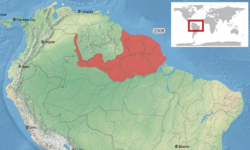Biology:Chiasmocleis hudsoni
| Chiasmocleis hudsoni | |
|---|---|
| Scientific classification | |
| Domain: | Eukaryota |
| Kingdom: | Animalia |
| Phylum: | Chordata |
| Class: | Amphibia |
| Order: | Anura |
| Family: | Microhylidae |
| Genus: | Chiasmocleis |
| Species: | C. hudsoni
|
| Binomial name | |
| Chiasmocleis hudsoni Parker, 1940
| |

| |
| Range as known in 2004. The species is now known to occur in Colombia and more widely in Brazil. | |
| Synonyms[2] | |
| |
Chiasmocleis hudsoni, also known as Hudson's humming frog, is a species of frog in the family Microhylidae. It is found in French Guiana, Suriname, Guyana, Guianan Venezuela, Colombia (Amazonas), and Amazonian Brazil .[2] Chiasmocleis jimi has been included in this species but the most recent genetic analyses support its recognition as a distinct species; both species might include further distinct lineages that warrant recognition as species.[3]
Etymology
The specific name hudsoni honours C. A. Hudson, the collector of the holotype and a collector for the Natural History Museum, London.[4]
Description
Adult males measure 14–23 mm (0.6–0.9 in) and adult females 17–28 mm (0.7–1.1 in) in snout–vent length. The body is robust and ovoid. The head is much narrower than the body; the snout is rounded. All but the first finger are fringed; no webbing is present. The finger tips are rounded and fingers 2–3 are swollen and may present discs. The toes are slightly fringed but have no webbing. Toes 2–4 have terminal discs. The dorsum is purple brown with variable lighter markings. The snout can be white.[5]
Males may possess few but large dermal spines on the chin. The male advertisement call is a repetitive series of multi-pulsed notes.[5]
Habitat and conservation
Chiasmocleis hudsoni is a common species living in tropical rainforests at elevations below 300 m (980 ft). It is a nocturnal, fossorial frog, usually hiding in holes or in the leaf litter. It is an "explosive breeder" using temporary pools for breeding. It is locally threatened by habitat loss caused by clear-cutting. However, it is not threatened overall, and it is present in several protected areas.[1]
References
- ↑ 1.0 1.1 Miguel Trefaut Rodrigues, Robert Reynolds, César Luis Barrio Amorós (2004). "Chiasmocleis hudsoni". IUCN Red List of Threatened Species 2004: e.T57757A11681166. doi:10.2305/IUCN.UK.2004.RLTS.T57757A11681166.en. https://www.iucnredlist.org/species/57757/11681166. Retrieved 16 November 2021.
- ↑ 2.0 2.1 Frost, Darrel R. (2019). "Chiasmocleis hudsoni Parker, 1940". Amphibian Species of the World: an Online Reference. Version 6.0. American Museum of Natural History. http://research.amnh.org/vz/herpetology/amphibia/Amphibia/Anura/Microhylidae/Gastrophryninae/Chiasmocleis/Chiasmocleis-hudsoni. Retrieved 16 December 2019.
- ↑ de Sá, Rafael O.; Tonini, João Filipe Riva; van Huss, Hannah; Long, Alex; Cuddy, Travis; Forlani, Mauricio C.; Peloso, Pedro L. V.; Zaher, Hussam et al. (2019). "Multiple connections between Amazonia and Atlantic Forest shaped the phylogenetic and morphological diversity of Chiasmocleis Mehely, 1904 (Anura: Microhylidae: Gastrophryninae)". Molecular Phylogenetics and Evolution 130: 198–210. doi:10.1016/j.ympev.2018.10.021. PMID 30347238.
- ↑ Beolens, Bo; Watkins, Michael; Grayson, Michael (2013). The Eponym Dictionary of Amphibians. Pelagic Publishing. p. 99. ISBN 978-1-907807-42-8. https://play.google.com/books/reader?id=QJY3BAAAQBAJ&pg=GBS.PA99.
- ↑ 5.0 5.1 Peloso, Pedro L. V.; Sturaro, Marcelo José; Forlani, Mauricio C.; Gaucher, Philippe; Motta, Ana Paula; Wheeler, Ward (2014). "Phylogeny, taxonomic revision, and character evolution of the genera Chiasmocleis and Syncope (Anura, Microhylidae) in Amazonia, with descriptions of three new species". Bulletin of the American Museum of Natural History 386: 1–96. doi:10.1206/834.1. https://www.biodiversitylibrary.org/itempdf/299846.
Wikidata ☰ Q2241870 entry
 |


